tire MAZDA MODEL CX-5 2013 (in English) User Guide
[x] Cancel search | Manufacturer: MAZDA, Model Year: 2013, Model line: MODEL CX-5, Model: MAZDA MODEL CX-5 2013Pages: 488, PDF Size: 8.75 MB
Page 120 of 488
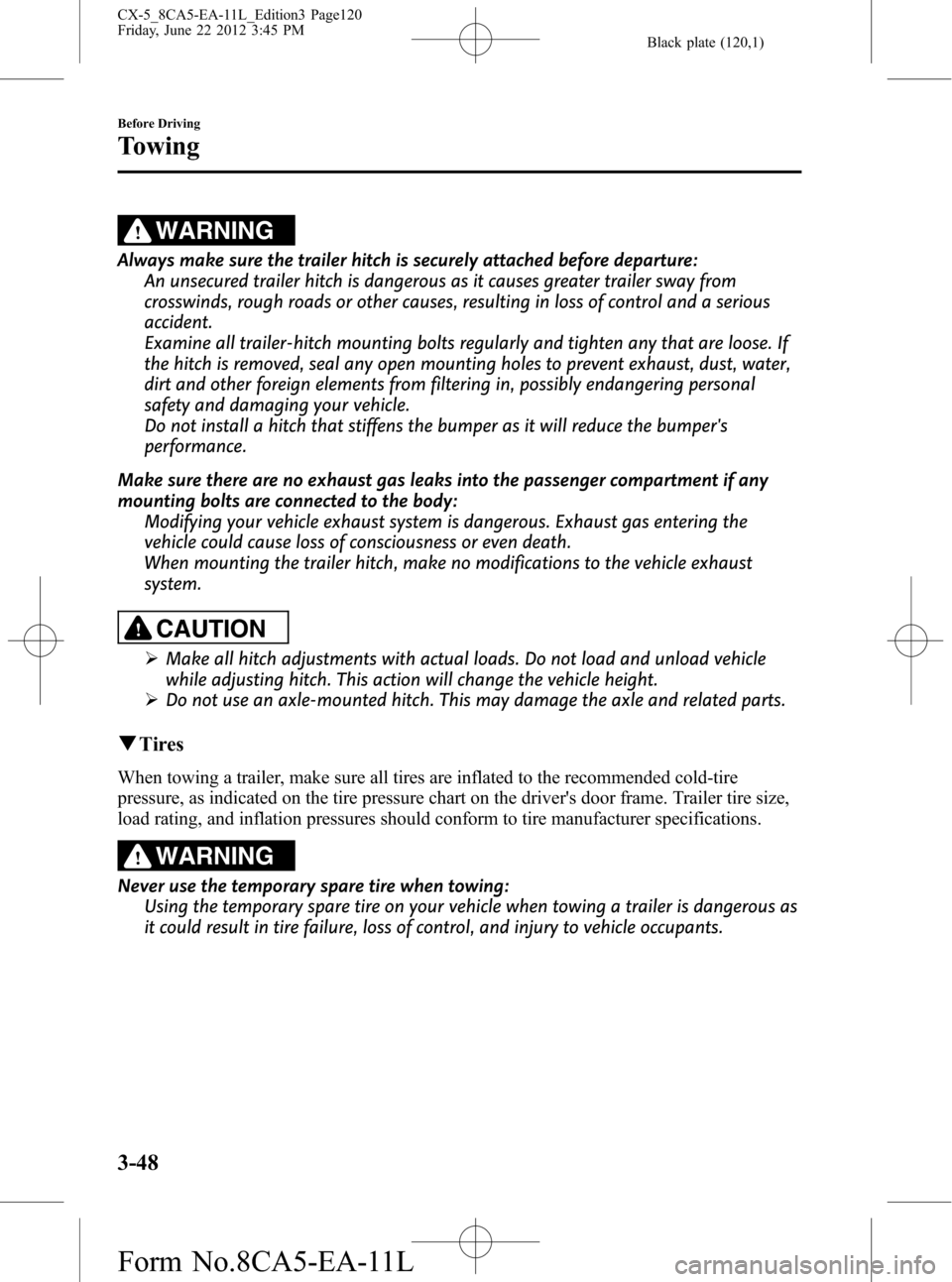
Black plate (120,1)
WARNING
Always make sure the trailer hitch is securely attached before departure:
An unsecured trailer hitch is dangerous as it causes greater trailer sway from
crosswinds, rough roads or other causes, resulting in loss of control and a serious
accident.
Examine all trailer-hitch mounting bolts regularly and tighten any that are loose. If
the hitch is removed, seal any open mounting holes to prevent exhaust, dust, water,
dirt and other foreign elements from filtering in, possibly endangering personal
safety and damaging your vehicle.
Do not install a hitch that stiffens the bumper as it will reduce the bumper's
performance.
Make sure there are no exhaust gas leaks into the passenger compartment if any
mounting bolts are connected to the body:
Modifying your vehicle exhaust system is dangerous. Exhaust gas entering the
vehicle could cause loss of consciousness or even death.
When mounting the trailer hitch, make no modifications to the vehicle exhaust
system.
CAUTION
ØMake all hitch adjustments with actual loads. Do not load and unload vehicle
while adjusting hitch. This action will change the vehicle height.
ØDo not use an axle-mounted hitch. This may damage the axle and related parts.
qTires
When towing a trailer, make sure all tires are inflated to the recommended cold-tire
pressure, as indicated on the tire pressure chart on the driver's door frame. Trailer tire size,
load rating, and inflation pressures should conform to tire manufacturer specifications.
WARNING
Never use the temporary spare tire when towing:
Using the temporary spare tire on your vehicle when towing a trailer is dangerous as
it could result in tire failure, loss of control, and injury to vehicle occupants.
3-48
Before Driving
Towing
CX-5_8CA5-EA-11L_Edition3 Page120
Friday, June 22 2012 3:45 PM
Form No.8CA5-EA-11L
Page 123 of 488
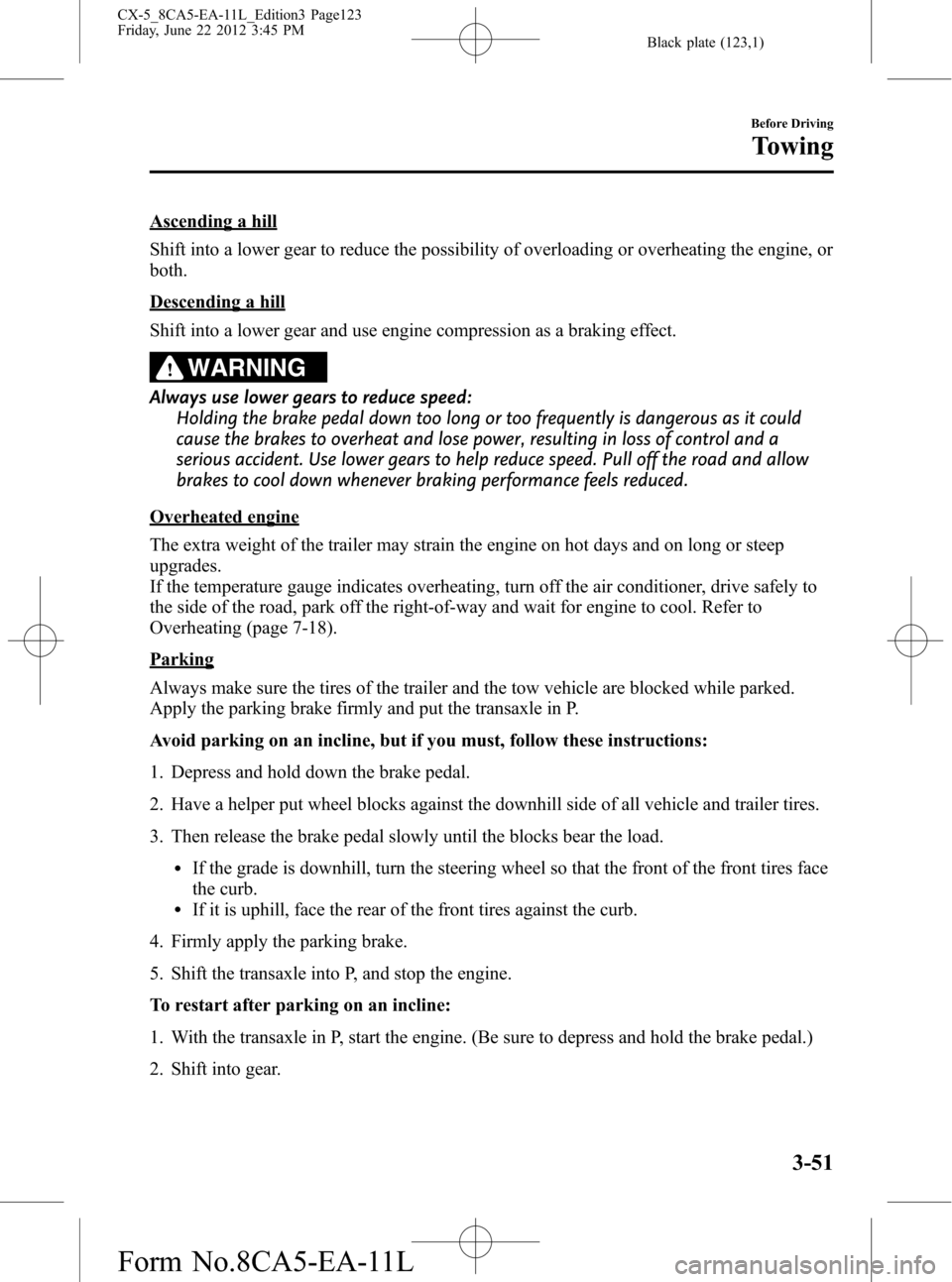
Black plate (123,1)
Ascending a hill
Shift into a lower gear to reduce the possibility of overloading or overheating the engine, or
both.
Descending a hill
Shift into a lower gear and use engine compression as a braking effect.
WARNING
Always use lower gears to reduce speed:
Holding the brake pedal down too long or too frequently is dangerous as it could
cause the brakes to overheat and lose power, resulting in loss of control and a
serious accident. Use lower gears to help reduce speed. Pull off the road and allow
brakes to cool down whenever braking performance feels reduced.
Overheated engine
The extra weight of the trailer may strain the engine on hot days and on long or steep
upgrades.
If the temperature gauge indicates overheating, turn off the air conditioner, drive safely to
the side of the road, park off the right-of-way and wait for engine to cool. Refer to
Overheating (page 7-18).
Parking
Always make sure the tires of the trailer and the tow vehicle are blocked while parked.
Apply the parking brake firmly and put the transaxle in P.
Avoid parking on an incline, but if you must, follow these instructions:
1. Depress and hold down the brake pedal.
2. Have a helper put wheel blocks against the downhill side of all vehicle and trailer tires.
3. Then release the brake pedal slowly until the blocks bear the load.
lIf the grade is downhill, turn the steering wheel so that the front of the front tires face
the curb.
lIf it is uphill, face the rear of the front tires against the curb.
4. Firmly apply the parking brake.
5. Shift the transaxle into P, and stop the engine.
To restart after parking on an incline:
1. With the transaxle in P, start the engine. (Be sure to depress and hold the brake pedal.)
2. Shift into gear.
Before Driving
Towing
3-51
CX-5_8CA5-EA-11L_Edition3 Page123
Friday, June 22 2012 3:45 PM
Form No.8CA5-EA-11L
Page 125 of 488
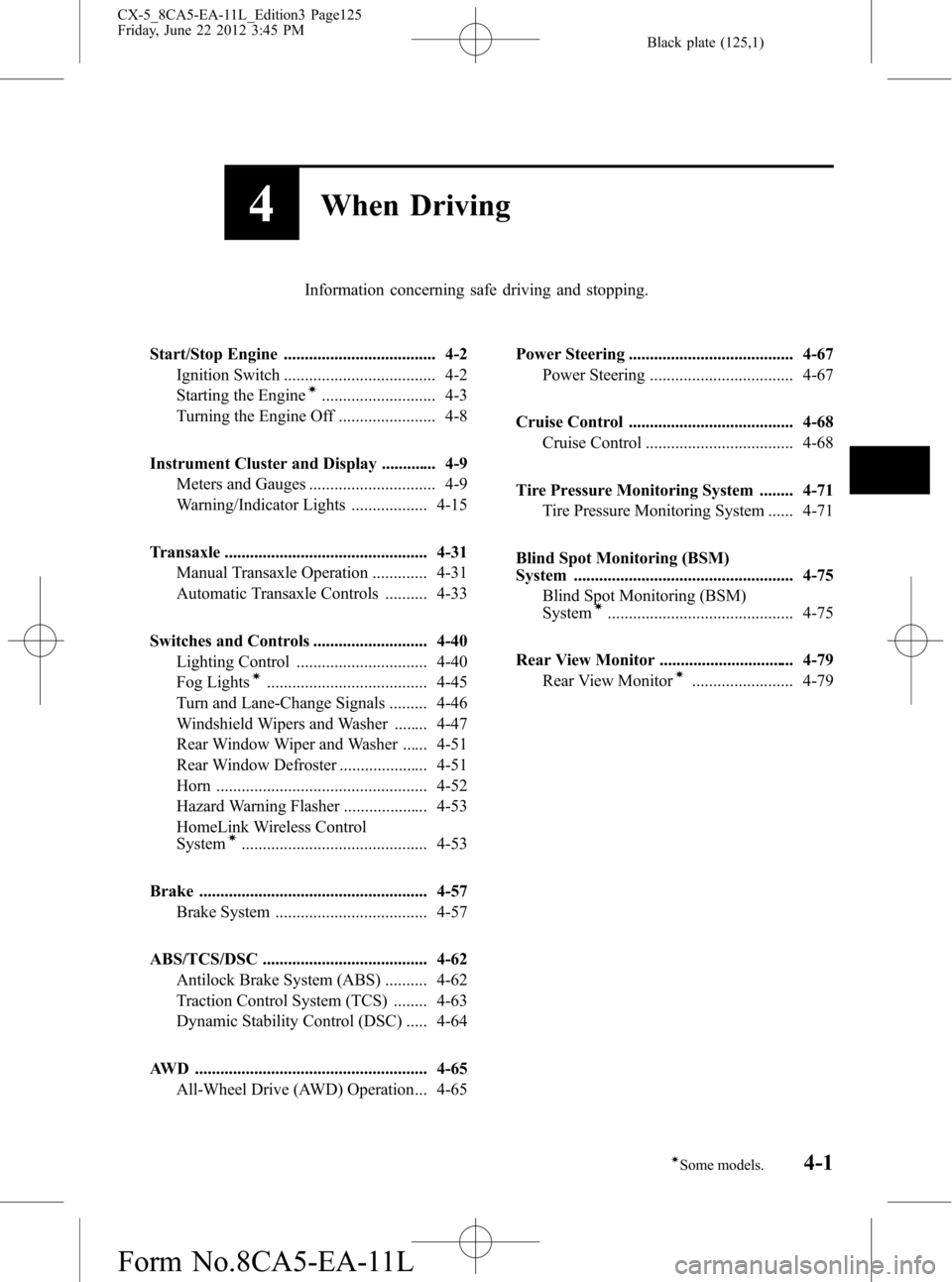
Black plate (125,1)
4When Driving
Information concerning safe driving and stopping.
Start/Stop Engine .................................... 4-2
Ignition Switch .................................... 4-2
Starting the Engine
í........................... 4-3
Turning the Engine Off ....................... 4-8
Instrument Cluster and Display ............. 4-9
Meters and Gauges .............................. 4-9
Warning/Indicator Lights .................. 4-15
Transaxle ................................................ 4-31
Manual Transaxle Operation ............. 4-31
Automatic Transaxle Controls .......... 4-33
Switches and Controls ........................... 4-40
Lighting Control ............................... 4-40
Fog Lights
í...................................... 4-45
Turn and Lane-Change Signals ......... 4-46
Windshield Wipers and Washer ........ 4-47
Rear Window Wiper and Washer ...... 4-51
Rear Window Defroster ..................... 4-51
Horn .................................................. 4-52
Hazard Warning Flasher .................... 4-53
HomeLink Wireless Control
System
í............................................ 4-53
Brake ...................................................... 4-57
Brake System .................................... 4-57
ABS/TCS/DSC ....................................... 4-62
Antilock Brake System (ABS) .......... 4-62
Traction Control System (TCS) ........ 4-63
Dynamic Stability Control (DSC) ..... 4-64
AWD ....................................................... 4-65
All-Wheel Drive (AWD) Operation... 4-65Power Steering ....................................... 4-67
Power Steering .................................. 4-67
Cruise Control ....................................... 4-68
Cruise Control ................................... 4-68
Tire Pressure Monitoring System ........ 4-71
Tire Pressure Monitoring System ...... 4-71
Blind Spot Monitoring (BSM)
System .................................................... 4-75
Blind Spot Monitoring (BSM)
System
í............................................ 4-75
Rear View Monitor ................................ 4-79
Rear View Monitor
í........................ 4-79
4-1íSome models.
CX-5_8CA5-EA-11L_Edition3 Page125
Friday, June 22 2012 3:45 PM
Form No.8CA5-EA-11L
Page 140 of 488
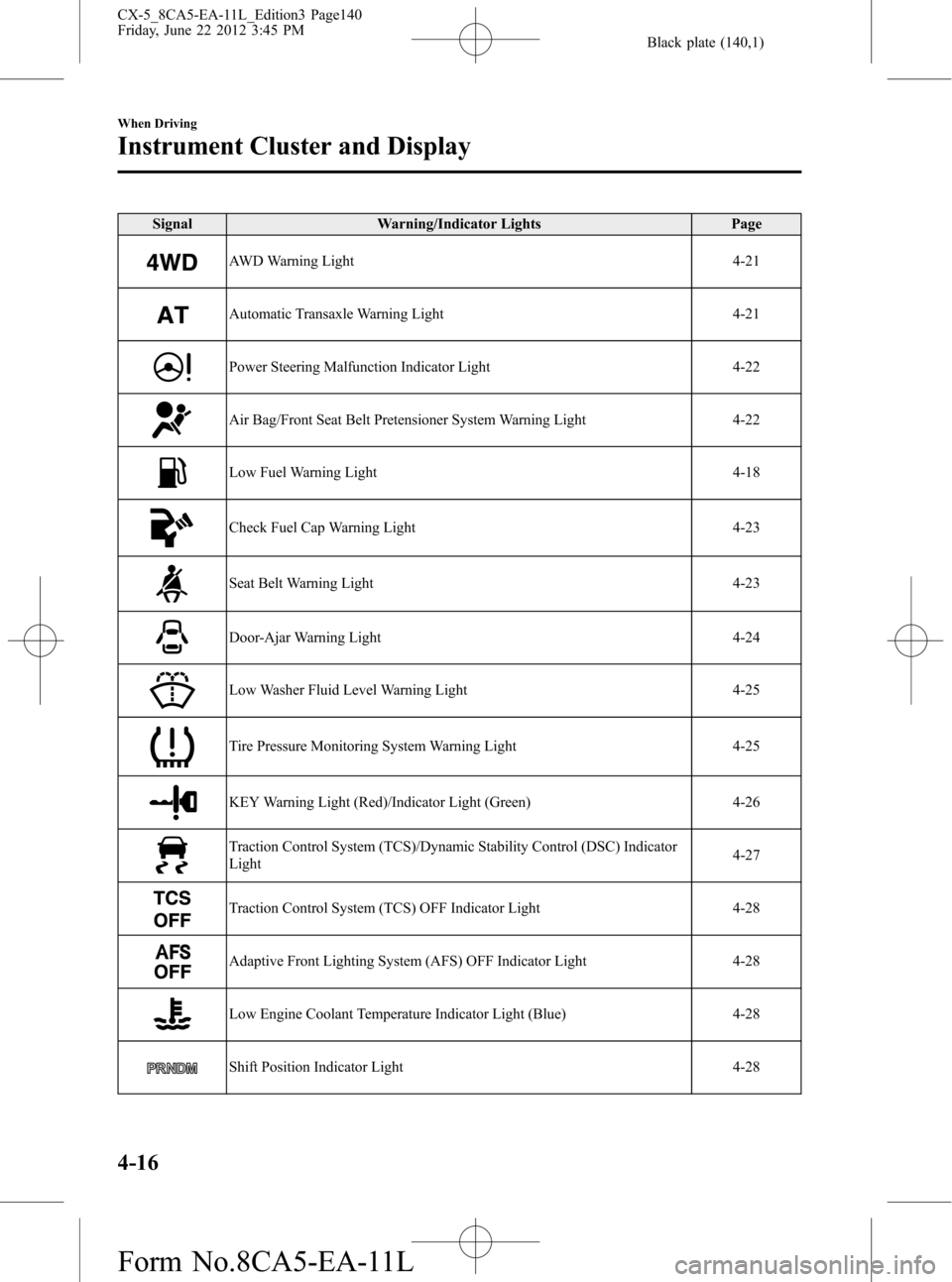
Black plate (140,1)
Signal Warning/Indicator Lights Page
AWD Warning Light 4-21
Automatic Transaxle Warning Light 4-21
Power Steering Malfunction Indicator Light 4-22
Air Bag/Front Seat Belt Pretensioner System Warning Light 4-22
Low Fuel Warning Light 4-18
Check Fuel Cap Warning Light 4-23
Seat Belt Warning Light 4-23
Door-Ajar Warning Light 4-24
Low Washer Fluid Level Warning Light 4-25
Tire Pressure Monitoring System Warning Light 4-25
KEY Warning Light (Red)/Indicator Light (Green) 4-26
Traction Control System (TCS)/Dynamic Stability Control (DSC) Indicator
Light4-27
Traction Control System (TCS) OFF Indicator Light 4-28
Adaptive Front Lighting System (AFS) OFF Indicator Light 4-28
Low Engine Coolant Temperature Indicator Light (Blue) 4-28
Shift Position Indicator Light 4-28
4-16
When Driving
Instrument Cluster and Display
CX-5_8CA5-EA-11L_Edition3 Page140
Friday, June 22 2012 3:45 PM
Form No.8CA5-EA-11L
Page 145 of 488
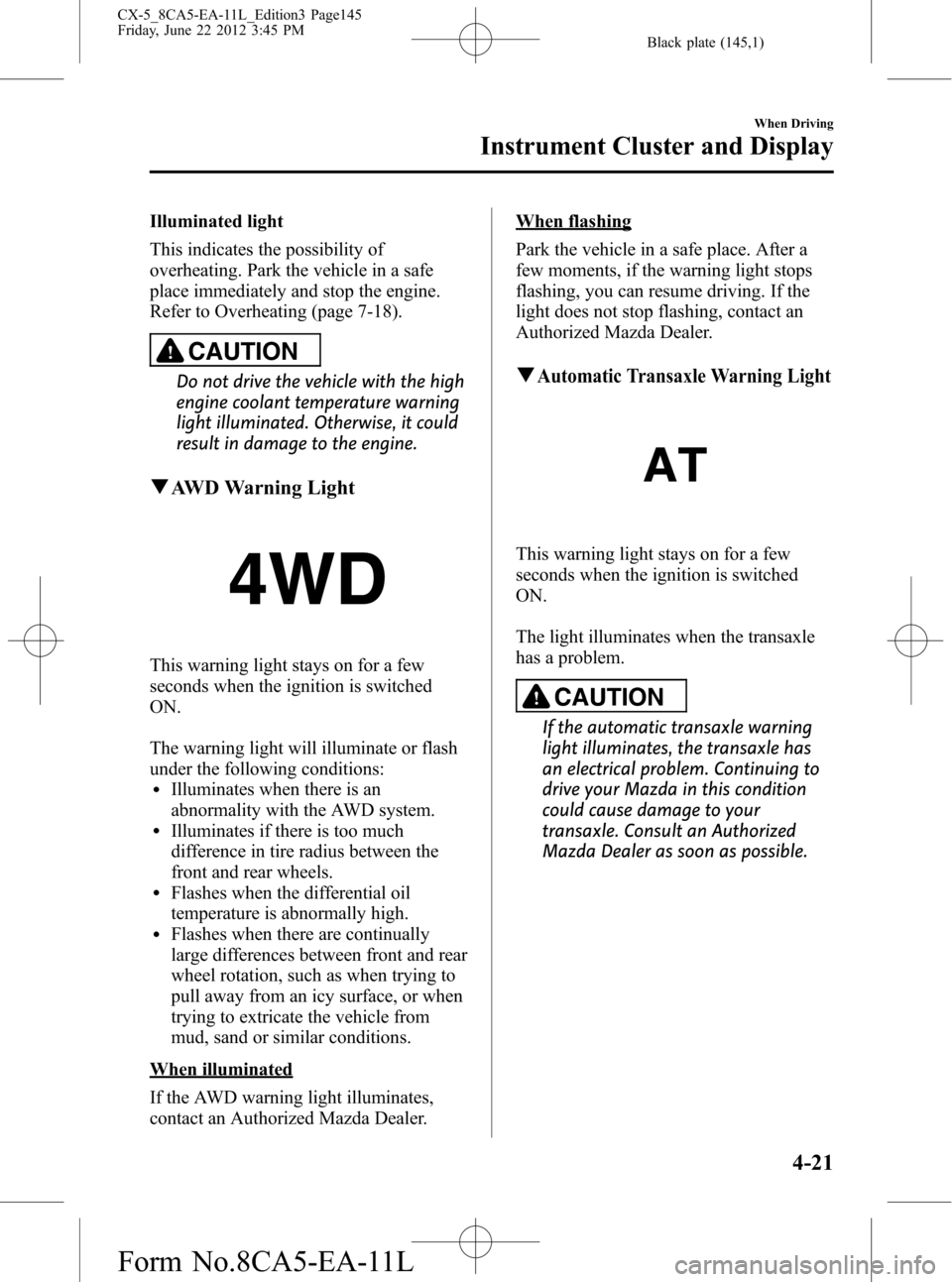
Black plate (145,1)
Illuminated light
This indicates the possibility of
overheating. Park the vehicle in a safe
place immediately and stop the engine.
Refer to Overheating (page 7-18).
CAUTION
Do not drive the vehicle with the high
engine coolant temperature warning
light illuminated. Otherwise, it could
result in damage to the engine.
qAWD Warning Light
This warning light stays on for a few
seconds when the ignition is switched
ON.
The warning light will illuminate or flash
under the following conditions:
lIlluminates when there is an
abnormality with the AWD system.
lIlluminates if there is too much
difference in tire radius between the
front and rear wheels.
lFlashes when the differential oil
temperature is abnormally high.
lFlashes when there are continually
large differences between front and rear
wheel rotation, such as when trying to
pull away from an icy surface, or when
trying to extricate the vehicle from
mud, sand or similar conditions.
When illuminated
If the AWD warning light illuminates,
contact an Authorized Mazda Dealer.
When flashing
Park the vehicle in a safe place. After a
few moments, if the warning light stops
flashing, you can resume driving. If the
light does not stop flashing, contact an
Authorized Mazda Dealer.
qAutomatic Transaxle Warning Light
This warning light stays on for a few
seconds when the ignition is switched
ON.
The light illuminates when the transaxle
has a problem.
CAUTION
If the automatic transaxle warning
light illuminates, the transaxle has
an electrical problem. Continuing to
drive your Mazda in this condition
could cause damage to your
transaxle. Consult an Authorized
Mazda Dealer as soon as possible.
When Driving
Instrument Cluster and Display
4-21
CX-5_8CA5-EA-11L_Edition3 Page145
Friday, June 22 2012 3:45 PM
Form No.8CA5-EA-11L
Page 149 of 488

Black plate (149,1)
qLow Washer Fluid Level
Warning Lightí
This warning light indicates that little
washer fluid remains. Add fluid (page
6-26).
qTire Pressure Monitoring System
Warning Light
This warning light illuminates for a few
seconds when the ignition is switched
ON.
The warning light illuminates and a beep
is heard when tire pressure is too low in
one or more tires, and flashes when there
is a system malfunction.
WARNING
If the tire pressure monitoring system
warning light illuminates or flashes, or
the tire pressure warning beep sound is
heard, decrease vehicle speed
immediately and avoid sudden
maneuvering and braking:
If the tire pressure monitoring system
warning light illuminates or flashes,
or the tire pressure warning beep
sound is heard, it is dangerous to
drive the vehicle at high speeds, or
perform sudden maneuvering or
braking. Vehicle drivability could
worsen and result in an accident.
To determine if you have a slow leak
or a flat, pull over to a safe position
where you can check the visual
condition of the tire and determine if
you have enough air to proceed to a
place where air may be added and
the system monitored again by an
Authorized Mazda Dealer or a tire
repair station.
Do not ignore the TPMS Warning Light:
Ignoring the TPMS warning light is
dangerous, even if you know why it is
illuminated. Have the problem taken
care of as soon as possible before it
develops into a more serious
situation that could lead to tire
failure and a dangerous accident.
Warning light illuminates/Warning
beep sounds
When the warning light illuminates, and
the warning beep sound is heard (about 3
seconds), tire pressure is too low in one or
more tires.
When Driving
Instrument Cluster and Display
4-25íSome models. CX-5_8CA5-EA-11L_Edition3 Page149
Friday, June 22 2012 3:45 PM
Form No.8CA5-EA-11L
Page 150 of 488
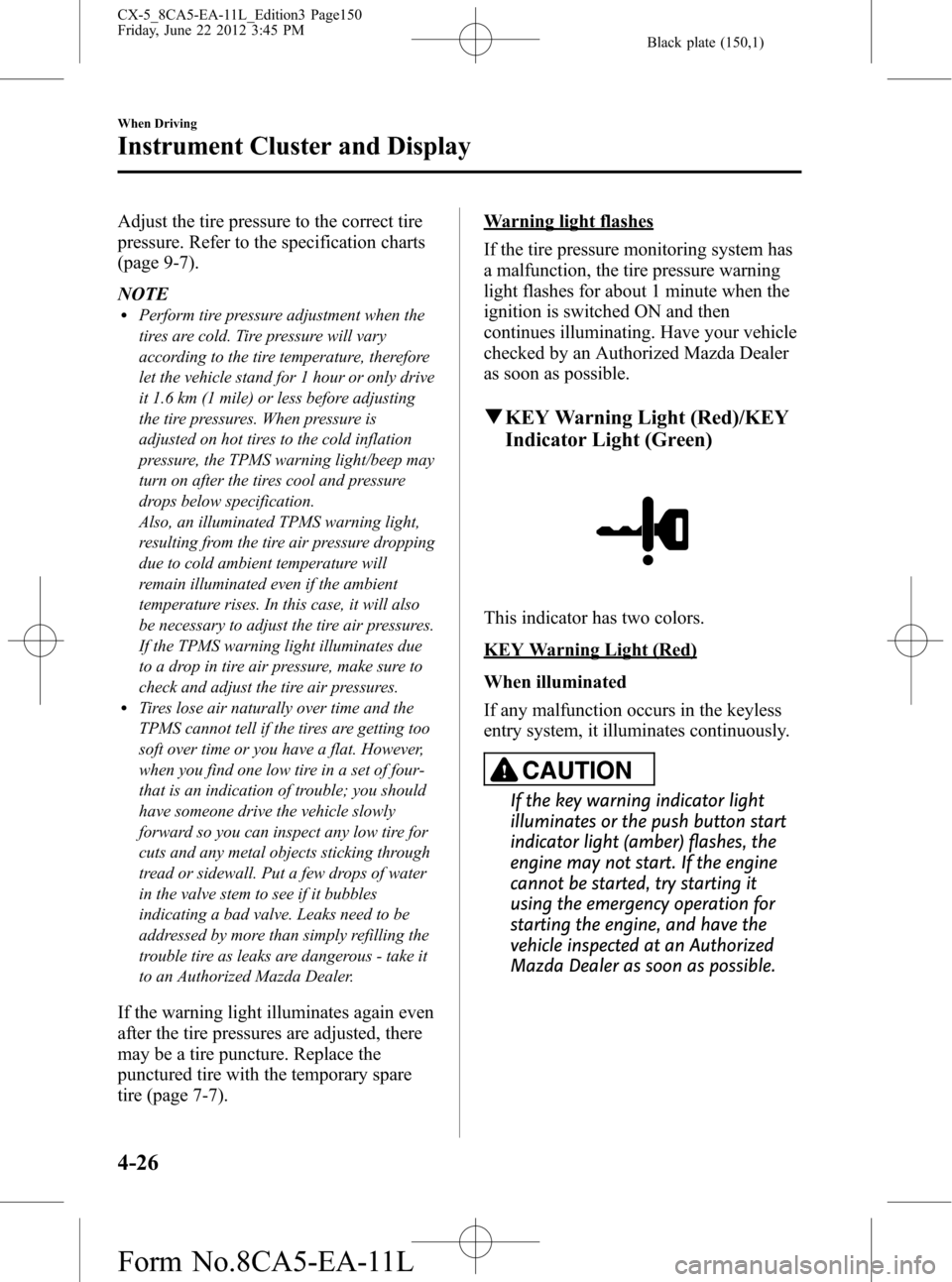
Black plate (150,1)
Adjust the tire pressure to the correct tire
pressure. Refer to the specification charts
(page 9-7).
NOTE
lPerform tire pressure adjustment when the
tires are cold. Tire pressure will vary
according to the tire temperature, therefore
let the vehicle stand for 1 hour or only drive
it 1.6 km (1 mile) or less before adjusting
the tire pressures. When pressure is
adjusted on hot tires to the cold inflation
pressure, the TPMS warning light/beep may
turn on after the tires cool and pressure
drops below specification.
Also, an illuminated TPMS warning light,
resulting from the tire air pressure dropping
due to cold ambient temperature will
remain illuminated even if the ambient
temperature rises. In this case, it will also
be necessary to adjust the tire air pressures.
If the TPMS warning light illuminates due
to a drop in tire air pressure, make sure to
check and adjust the tire air pressures.
lTires lose air naturally over time and the
TPMS cannot tell if the tires are getting too
soft over time or you have a flat. However,
when you find one low tire in a set of four-
that is an indication of trouble; you should
have someone drive the vehicle slowly
forward so you can inspect any low tire for
cuts and any metal objects sticking through
tread or sidewall. Put a few drops of water
in the valve stem to see if it bubbles
indicating a bad valve. Leaks need to be
addressed by more than simply refilling the
trouble tire as leaks are dangerous - take it
to an Authorized Mazda Dealer.
If the warning light illuminates again even
after the tire pressures are adjusted, there
may be a tire puncture. Replace the
punctured tire with the temporary spare
tire (page 7-7).
Warning light flashes
If the tire pressure monitoring system has
a malfunction, the tire pressure warning
light flashes for about 1 minute when the
ignition is switched ON and then
continues illuminating. Have your vehicle
checked by an Authorized Mazda Dealer
as soon as possible.
qKEY Warning Light (Red)/KEY
Indicator Light (Green)
This indicator has two colors.
KEY Warning Light (Red)
When illuminated
If any malfunction occurs in the keyless
entry system, it illuminates continuously.
CAUTION
If the key warning indicator light
illuminates or the push button start
indicator light (amber) flashes, the
engine may not start. If the engine
cannot be started, try starting it
using the emergency operation for
starting the engine, and have the
vehicle inspected at an Authorized
Mazda Dealer as soon as possible.
4-26
When Driving
Instrument Cluster and Display
CX-5_8CA5-EA-11L_Edition3 Page150
Friday, June 22 2012 3:45 PM
Form No.8CA5-EA-11L
Page 155 of 488
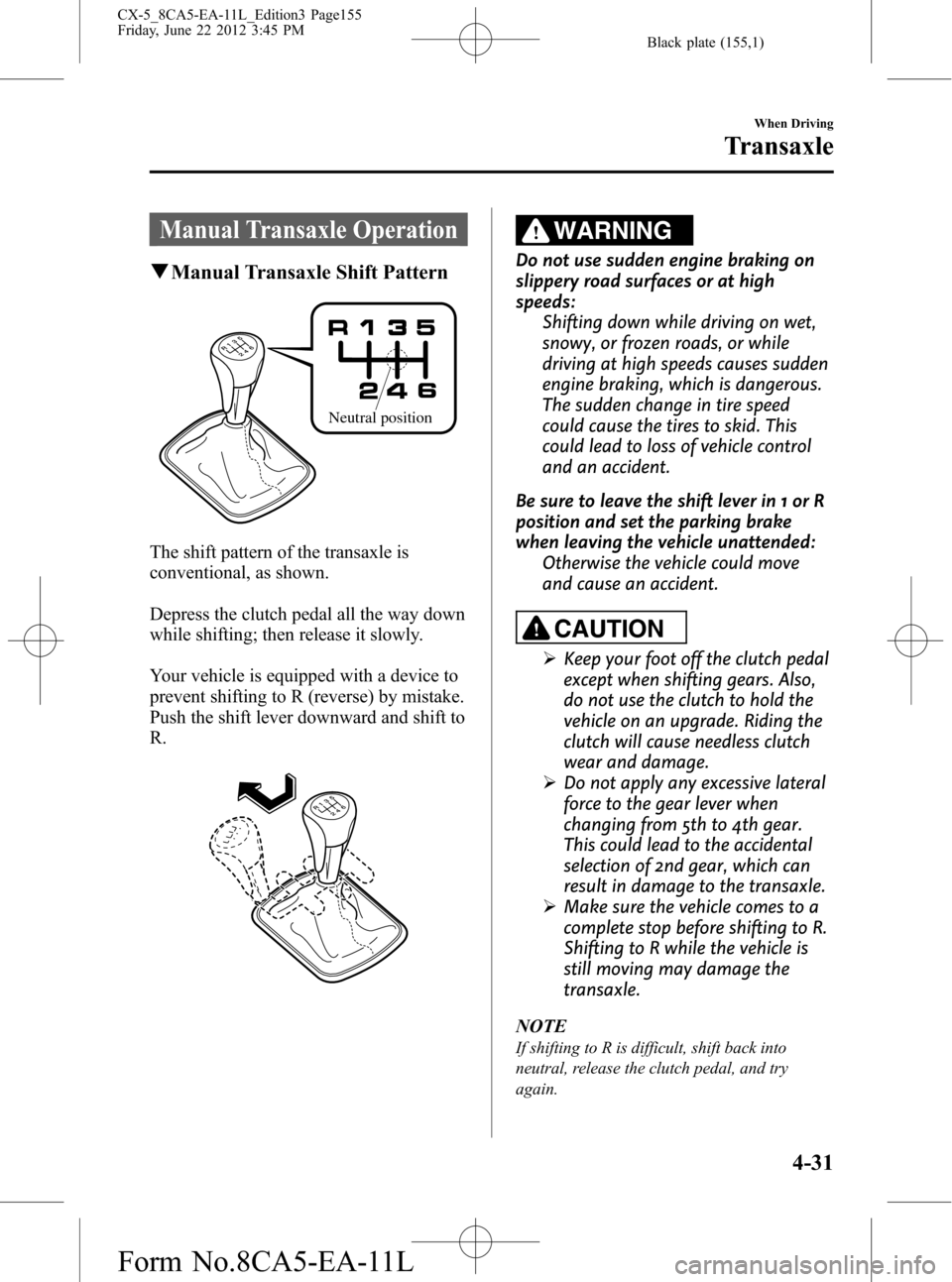
Black plate (155,1)
Manual Transaxle Operation
qManual Transaxle Shift Pattern
Neutral position
The shift pattern of the transaxle is
conventional, as shown.
Depress the clutch pedal all the way down
while shifting; then release it slowly.
Your vehicle is equipped with a device to
prevent shifting to R (reverse) by mistake.
Push the shift lever downward and shift to
R.
WARNING
Do not use sudden engine braking on
slippery road surfaces or at high
speeds:
Shifting down while driving on wet,
snowy, or frozen roads, or while
driving at high speeds causes sudden
engine braking, which is dangerous.
The sudden change in tire speed
could cause the tires to skid. This
could lead to loss of vehicle control
and an accident.
Be sure to leave the shift lever in 1 or R
position and set the parking brake
when leaving the vehicle unattended:
Otherwise the vehicle could move
and cause an accident.
CAUTION
ØKeep your foot off the clutch pedal
except when shifting gears. Also,
do not use the clutch to hold the
vehicle on an upgrade. Riding the
clutch will cause needless clutch
wear and damage.
ØDo not apply any excessive lateral
force to the gear lever when
changing from 5th to 4th gear.
This could lead to the accidental
selection of 2nd gear, which can
result in damage to the transaxle.
ØMake sure the vehicle comes to a
complete stop before shifting to R.
Shifting to R while the vehicle is
still moving may damage the
transaxle.
NOTE
If shifting to R is difficult, shift back into
neutral, release the clutch pedal, and try
again.
When Driving
Transaxle
4-31
CX-5_8CA5-EA-11L_Edition3 Page155
Friday, June 22 2012 3:45 PM
Form No.8CA5-EA-11L
Page 161 of 488

Black plate (161,1)
Shifting
Manually Shifting up
(M1→M2→M3→M4→M5→M6)
To shift up to a higher gear, tap the shift
lever back (
) once.
NOTElWhen driving slowly, the gears may not
shift up.
lIn manual shift mode, do not run the engine
with the tachometer needle in the RED
ZONE. When the engine rpm is high, a gear
may shift up automatically to protect the
engine.
lWhen depressing the accelerator fully, the
transaxle will shift to a lower gear,
depending on vehicle speed (Except M2→
M1).
Manually Shifting down
(M6→M5→M4→M3→M2→M1)
To shift down to a lower gear, tap the shift
lever forward (
) once.
WARNING
Do not use engine braking on slippery
road surfaces or at high speeds:
Shifting down while driving on wet,
snowy, or frozen roads, or while
driving at high speeds causes sudden
engine braking, which is dangerous.
The sudden change in tire speed
could cause the tires to skid. This
could lead to loss of vehicle control
and an accident.
NOTE
lWhen driving at high speeds, the gear may
not shift down.
lDuring deceleration, the gear may
automatically shift down depending on
vehicle speed.
lWhen depressing the accelerator fully, the
transaxle will shift to a lower gear,
depending on vehicle speed (Except M2→
M1).
When Driving
Transaxle
4-37
CX-5_8CA5-EA-11L_Edition3 Page161
Friday, June 22 2012 3:45 PM
Form No.8CA5-EA-11L
Page 186 of 488
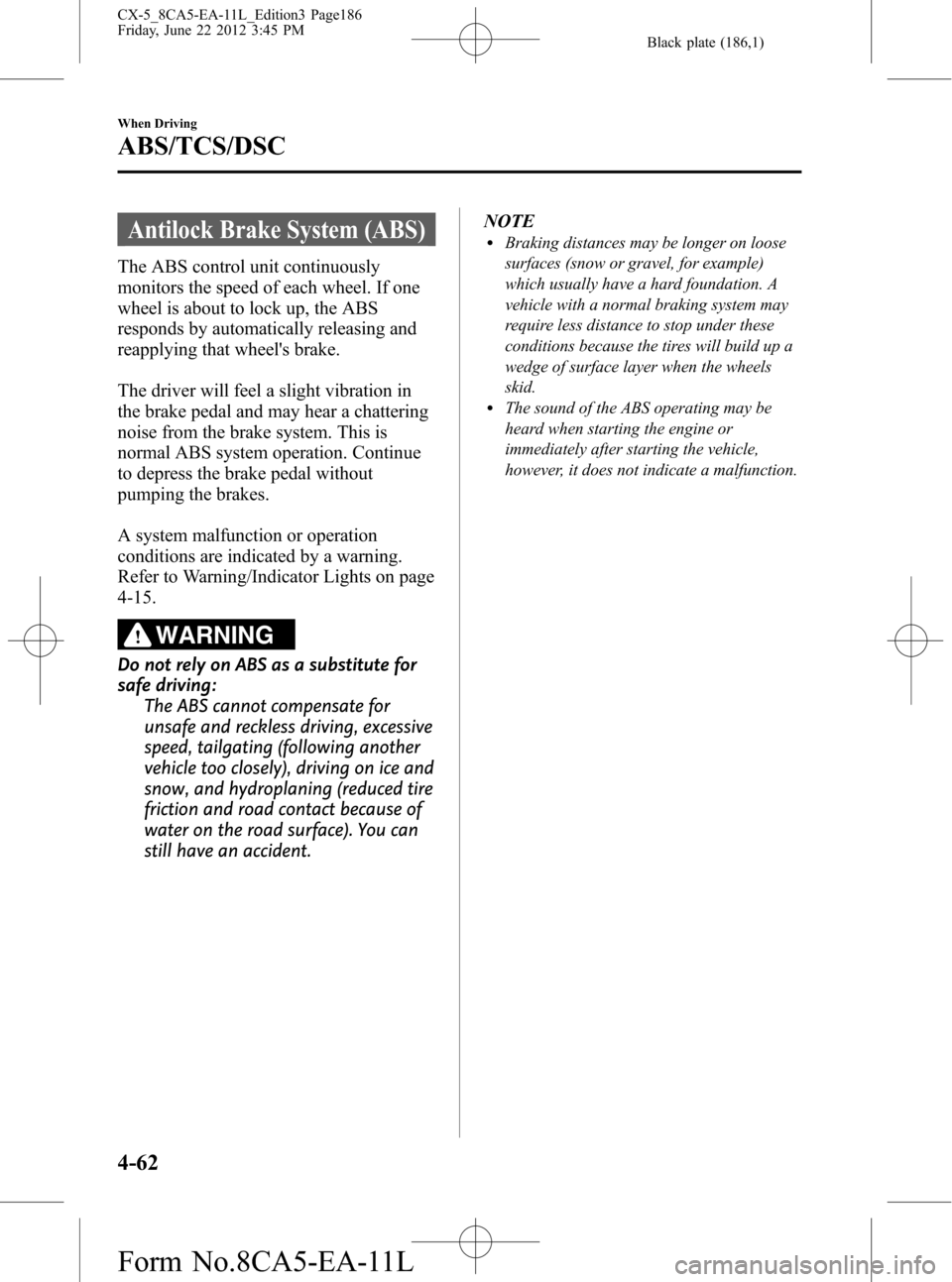
Black plate (186,1)
Antilock Brake System (ABS)
The ABS control unit continuously
monitors the speed of each wheel. If one
wheel is about to lock up, the ABS
responds by automatically releasing and
reapplying that wheel's brake.
The driver will feel a slight vibration in
the brake pedal and may hear a chattering
noise from the brake system. This is
normal ABS system operation. Continue
to depress the brake pedal without
pumping the brakes.
A system malfunction or operation
conditions are indicated by a warning.
Refer to Warning/Indicator Lights on page
4-15.
WARNING
Do not rely on ABS as a substitute for
safe driving:
The ABS cannot compensate for
unsafe and reckless driving, excessive
speed, tailgating (following another
vehicle too closely), driving on ice and
snow, and hydroplaning (reduced tire
friction and road contact because of
water on the road surface). You can
still have an accident.NOTE
lBraking distances may be longer on loose
surfaces (snow or gravel, for example)
which usually have a hard foundation. A
vehicle with a normal braking system may
require less distance to stop under these
conditions because the tires will build up a
wedge of surface layer when the wheels
skid.
lThe sound of the ABS operating may be
heard when starting the engine or
immediately after starting the vehicle,
however, it does not indicate a malfunction.
4-62
When Driving
ABS/TCS/DSC
CX-5_8CA5-EA-11L_Edition3 Page186
Friday, June 22 2012 3:45 PM
Form No.8CA5-EA-11L